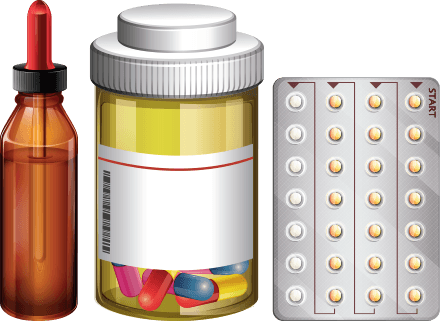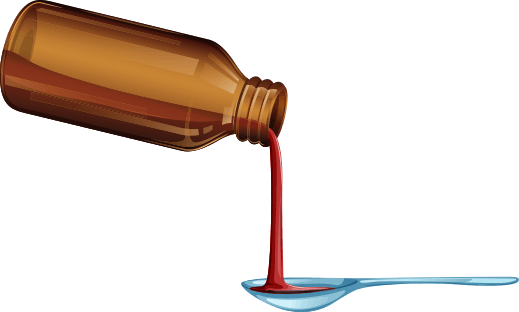Topic B: “Five Rights” of Medication Administration
[ms_quote cite=”Dr. Poole, Healthy Child Care America (1999)” url=”https://www.aap.org/en-us/advocacy-and-policy/aap-health-initiatives/healthy-child-care/Pages/Medication-Administration.aspx” class=”” id=””]“As many as 40-60% of children in a given child care setting may be on an antibiotic or over-the-counter medication during the winter months.
That means someone other than a health professional could be delivering 20-30 doses of antibiotics and over-the-counter medications in the room every day. There is a tremendous chance for missing a dose, giving too many doses, giving the wrong amount, or giving the medication at the wrong time. Medicine bottles shuttled back and forth between home and the child care facility are frequently forgotten as well, resulting in more missed doses.”[/ms_quote]
When administering medication, early care and education professionals should use the “five rights2,” asking themselves:
- Do I have the right child?
- Do I have the right medicine?
- Am I giving the right dose?
- Am I using the right route?
- Am I giving medicine at the right time?
“Five Rights” of Medication Administration
Let’s look at each of the “five rights” more closely. Click on each item to read more.
[ms_row] [ms_column style=”5/6″ align=”left” class=”” id=””][ms_accordion style=”simple” type=”1″ class=”” id=””] [ms_accordion_item title=”1. Do I have the right child?” color=”” background_color=”” close_icon=”” open_icon=”” status=”close”] Administering medication safely begins with ensuring you have the right child. Early childhood programs frequently have more than one child with the same first name. Even if you know the child’s name, double-check. Rather than asking “Are you John?” ask the child to state his/her name.[/ms_accordion_item] [ms_accordion_item title=”2. Do I have the right medicine?” color=”” background_color=”” close_icon=”” open_icon=”” status=”close”] Make sure you are giving the right medication. Many medication names are familiar, and a child may be taking more than one medicine at a time. Compare the medication to the medication permission slip, and then check the medication name three times before administering to the child. Check medication:- When picking up the medication bottle
- While preparing the correct dose
- Before administering to child[/ms_accordion_item]
- Do not use standard tableware tablespoons and teaspoons because they are NOT accurate. Use the oral dropper, syringe, dosing spoon (see proper dosing implements below) or medication cup that came with the medication.
- Avoid making conversions. If the label calls for one tablespoon and you only have a measuring spoon, do not use it. Obtain the appropriate measuring device.
- Do not confuse the abbreviations for tablespoon (TBSP or T) and teaspoon (tsp or t).[/ms_accordion_item]
- Should you shake the bottle?
- Do you have to wait between drops?
- Should it be taken with food?[/ms_accordion_item]
- To work properly, medication needs to be given consistently and at the right times. Before giving medication, check the medication log to determine when the last dose was given.
- Medication should be given within 30 minutes before or after the prescribed time.[/ms_accordion_item][/ms_accordion][/ms_column] [/ms_row]
Do I have the right child?

Administering medication safely begins with ensuring you have the right child. Early childhood programs frequently have more than one child with the same first name.
Even if you know the child’s name, double-check. Rather than asking “Are you John?” ask the child to state his/her name.
Do I have the right medicine?

Make sure you are giving the right medication. Many medication names are familiar, and a child may be taking more than one medicine at a time. Compare the medication to the medication permission slip, and then check the medication name three times before administering to the child.
Check medication:
- When picking up the medication bottle
- While preparing the correct dose
- Before administering to child
Am I giving the right dose?

Giving the right dose is critical. Dosage should never be guessed at or increased because the child seems sicker. Dosage mistakes often occur when an inappropriate measuring device is used.
Do not make the following mistakes:3
- Do not use standard tableware tablespoons and teaspoons because they are NOT accurate. Use the oral dropper, syringe, dosing spoon (see proper dosing implements below) or medication cup that came with the medication.
- Avoid making conversions. If the label calls for one tablespoon and you only have a measuring spoon, do not use it. Obtain the appropriate measuring device.
- Do not confuse the abbreviations for tablespoon (TBSP or T) and teaspoon (tsp or t).
Am I using the right route?

Make sure you use the right method (route) for administering medication (i.e., mouth, skin, ear).
Pay close attention to the directions:
- Should you shake the bottle?
- Do you have to wait between drops?
- Should it be taken with food?
Am I giving medicine at the right time?

To work properly, medication needs to be given consistently and at the right times. Before giving medication, check the medication log to determine when the last dose was given.
Medication should be given within 30 minutes before or after the prescribed time.
